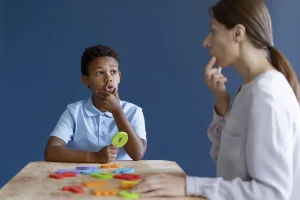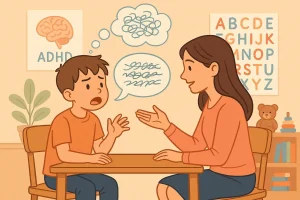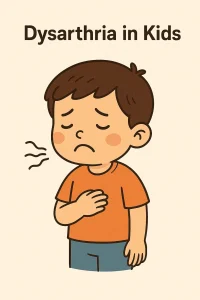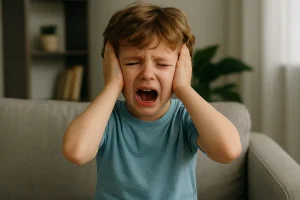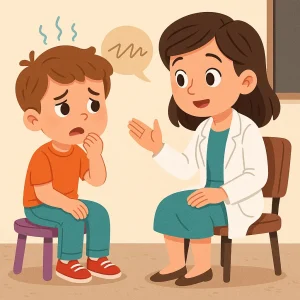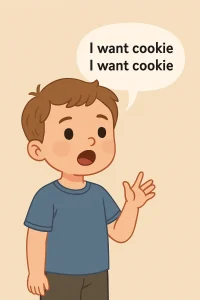How to Teach WH Questions to Kids at Home – Fun & Easy Tips!
By Rajini D
Last Updated: February 5, 2025
Teaching children how to use and understand WH questions—Who, What, When, Where, Why, and How—is a fundamental aspect of their language development and cognitive growth. These questions form the backbone of everyday conversation and play a critical role in how we gather information, solve problems, and connect with others. Here, we’ll explore why these questions are essential for child development and provide a basic overview to help you start teaching these key concepts at home. This guide aims to effectively teach WH questions to kids at home, ensuring they can apply these skills in daily interactions.
Importance of WH Questions in Child Development
WH questions are more than just components of speech; they are tools that enable children to inquire about the world around them. Mastering these questions helps kids improve their communication skills, enhances their comprehension abilities, and encourages curiosity and active learning. By learning to ask and answer WH questions, children develop critical thinking skills that are essential throughout their educational journey and beyond.
Overview of WH Questions: Who, What, When, Where, Why, and How
- Who questions are all about people. They help children understand identities and relationships. For example, “Who is your teacher?” or “Who is coming to the party?”
- What questions focus on objects, descriptions, and information. These questions can range from “What color is your car?” to “What did you learn at school today?”
- When questions are used to learn about time, allowing children to grasp the concept of past, present, and future events. Questions like “When is your birthday?” or “When did the movie start?” are common examples.
- Where questions pertain to places and locations, aiding in the spatial understanding. Kids learn to respond to “Where is your school?” or “Where did you put your toys?”
- Why questions dive into reasons behind actions and events, which is crucial for developing reasoning skills. They prompt deeper thinking, as in “Why do we eat breakfast?” or “Why is the sky blue?”
Also read: WH Questions for Kids: A Simple Guide to Teaching and Learning
Preparing to Teach WH Questions
Teaching WH questions at home doesn’t require a classroom’s worth of materials, but having the right tools and environment can make the learning process both enjoyable and effective. In this section, we’ll guide you through selecting essential materials and setting up a conducive learning space that encourages your child to engage with and master WH questions.
Essential Materials and Resources for Teaching at Home
When it comes to teaching WH questions, simplicity is key. Here are some essential materials and resources that can help you get started:
- Flashcards: Create or purchase flashcards with WH words and pictures representing their meanings. These visual aids can help reinforce understanding as you discuss various concepts.
- Children’s Books: Select books rich in narrative and dialogue that naturally incorporate WH questions. Reading stories aloud and discussing them can prompt your child to use these questions meaningfully.
- Printable Worksheets: Worksheets that focus on WH questions can be a fun way for children to practice. Wellness Hub offers downloadable resources that include engaging worksheets designed specifically for this purpose.
- Interactive Games: Board games or card games that require players to use WH questions to advance in the game are particularly effective. These games not only make learning fun but also encourage natural use of the language.
- Videos and Apps: Educational videos and apps that focus on question words can provide interactive and engaging ways for children to learn. Look for apps that provide feedback and adapt to your child’s learning pace.
Here’s a simple table to help you organize these resources:
| Material/Resource | Purpose | Example |
|---|---|---|
| Flashcards | Visual reinforcement of WH questions | WH question cards with pictures |
| Children’s Books | Contextual learning through stories | Books with rich dialogue and narratives |
| Printable Worksheets | Practice and reinforcement | Wellness Hub’s downloadable worksheets |
| Interactive Games | Engaging learning through play | Board games involving question words |
| Videos and Apps | Interactive digital learning | Educational apps with WH question games |
Creating a Conducive Learning Environment
A well-thought-out learning environment can significantly enhance your child’s ability to focus and engage. Consider these tips for creating a space that encourages learning:
- Quiet and Comfortable: Choose a quiet corner of your home free from distractions. Comfortable seating and good lighting can make learning sessions more inviting.
- Organized Space: Keep all learning materials organized and easily accessible. This helps in maintaining focus and saves time during learning sessions.
- Positive Reinforcement Area: Set up a small area where you can display your child’s accomplishments, such as completed worksheets or art projects related to their learning. This boosts confidence and motivation.
- Technology-Friendly Zone: If using digital resources, ensure there’s a dedicated space for your computer or tablet. This helps in establishing boundaries and proper usage of technology during learning times.
Also read: Why WH Questions Matter for Kids and How to Teach Them
Step-by-Step Guide to Teaching WH Questions
Teaching WH questions effectively starts with a clear, step-by-step approach that builds on your child’s understanding gradually and enjoyably. In this guide, we’ll walk you through introducing WH questions to young children and suggest progressive activities that make learning both fun and impactful.
Introducing WH Questions to Young Children
Simple Definitions and Examples
Start by explaining each WH question simply and clearly. Here’s a way to break it down for young learners:
- Who: Used to ask about people. Example: “Who is your favorite superhero?”
- What: Used to inquire about things, actions, or events. Example: “What are you drawing?”
- When: This question asks about time. Example: “When is your bedtime?”
- Where: Asks for a place or location. Example: “Where do you live?”
- Why: Seeks reasons or explanations. Example: “Why do we eat breakfast?”
- How: Used to find out the manner or process of something. Example: “How do you tie your shoes?”
Use everyday scenarios to practice these questions. For example, during a meal, you could ask, “What are you eating?” or “Why do you like it?” These everyday practice scenarios are crucial for reinforcing their learning in a natural context.
Progressive Activities for Teaching WH Questions
Games and Interactive Activities
Engaging games can make learning WH questions an interactive and dynamic process. Here are a few games that can help:
- WH Question Bingo: Create bingo cards with answers to different WH questions. Read the questions aloud, and your child marks the spot if they have the answer.
- Question Ball: Toss a ball back and forth. Each time someone catches it, they must ask a WH question. This keeps the game lively and educational.
- Role-Playing Games: Set up scenarios where your child can play different roles and must use WH questions to gather information or solve problems.
Here’s a quick table to outline these games:
| Game | Description | Key Benefit |
|---|---|---|
| WH Question Bingo | Bingo cards filled with WH question answers | Reinforces understanding of different WH question types |
| Question Ball | Tossing a ball and asking questions upon catching | Encourages quick thinking and question formation |
| Role-Playing Games | Creating scenarios for role-play that involve asking questions | Builds conversational skills and practical application |
Also read : WH Questions Examples for Kids: How to Teach with Fun Activities
Using Storytelling to Reinforce Understanding
Storytelling is a powerful method to deepen your child’s understanding of WH questions:
- Choose a story: Select a book or create a story that naturally incorporates WH questions.
- Interactive Reading: Pause at key points and ask your child WH questions about the story. For example, “Why did the character do that?” or “What do you think will happen next?”
- Story Creation: Encourage your child to create their own stories by guiding them with WH questions. This encourages them to think about the structure and content of their story in terms of who, what, when, where, why, and how.
Tips and Strategies for Effective Teaching
Teaching WH questions at home involves more than just structured lessons and activities. Integrating learning into daily interactions and using modern tools can significantly enhance your child’s understanding and use of these important questions. Here are some practical tips and strategies to make teaching WH questions effective and engaging.
Using Daily Conversations to Practice WH Questions
One of the most effective ways to teach WH questions is to weave them into daily conversations. This method helps children understand how these questions function in real-life situations and encourages them to use them naturally.
- Mealtime Inquiries: Use meal times to ask questions like, “What are you eating?”, “Why did you choose that?”, or “Who made dinner?”
- Outdoor Observations: While walking or playing outside, prompt your child with questions such as, “What do you see?”, “Why is the sky blue?”, or “How do plants grow?”
- Bedtime Stories: During story time, engage with questions like, “Who are the characters in the book?”, “What is the problem?”, and “How do you think it will be solved?”
Here’s how you can structure these practices:
| Time of Day | Possible WH Questions |
|---|---|
| Mealtime | What, Why, Who |
| Playtime | What, Where, How |
| Bedtime | Who, What, Why, How |
These routine interactions are opportunities to practice and reinforce the use of WH questions, making them a natural part of your child’s expressive toolkit.
Incorporating Multimedia Tools
Multimedia tools can provide dynamic and interactive ways to engage with and understand WH questions. Here’s how you can use these tools effectively:
- Educational Apps: Apps designed for language learning can include games and activities specifically tailored to using and understanding WH questions.
- Videos: Children’s educational programs often model conversational skills using WH questions. Discuss the videos afterward using similar questions to enhance comprehension and recall.
- Interactive eBooks: Many eBooks designed for children use stories that encourage interaction through WH questions, making reading an active learning experience.
Regular Review and Reinforcement Techniques
Consistent review and reinforcement are key to mastering WH questions. Here are some techniques to ensure your child retains and understands how to use these questions:
- Weekly Quizzes: Create simple quizzes that ask your child to formulate or answer WH questions based on their experiences or stories you’ve read together.
- Reward Systems: Implement a reward system for correctly using WH questions during conversations. This could be stickers, extra playtime, or a small treat.
- Progress Tracking: Keep a log of your child’s progress with different types of WH questions. Review it regularly to identify areas that need more practice.
Common Challenges and Solutions
Teaching WH questions at home can sometimes present unique challenges. Children may struggle with understanding the concepts, or they might find sustained engagement difficult. In this section, we’ll address these common challenges with practical solutions to help you keep lessons effective and engaging, ensuring your child not only learns but also enjoys the process.
Addressing Difficulties in Understanding WH Questions
Understanding WH questions can be tricky for young learners, especially when differentiating between the types. Here are some solutions to help clarify these differences and enhance comprehension:
- Use Clear and Consistent Examples: Consistency is key in teaching. Use the same examples to explain each question type until you’re confident your child understands. For instance, always start with the question “Who is it?” when you show a picture of a person.
- Break Down Questions: Simplify questions into smaller, more manageable parts. If a child struggles with “Why do we eat breakfast?”, you might first explain what breakfast is, then discuss its timing, and finally, talk about its importance.
- Visual Aids: Utilize charts and visual aids that categorize each WH question with corresponding symbols or pictures. This visual association can help cement the understanding of when to use each question.
- Role-Playing: Engage in role-playing games where you and your child ask each other WH questions. This practice can help reinforce the practical use and understanding of each question type.
Here’s a helpful breakdown to use as a reference:
| WH Question | Strategy | Example |
|---|---|---|
| Who | Use pictures of familiar people | “Who is this? (showing a family photo)” |
| What | Focus on objects and actions | “What are you playing with?” |
| When | Relate to daily routines | “When do we go to bed?” |
| Where | Connect to places around the home | “Where do we eat dinner?” |
| Why | Link to cause and effect | “Why do we wear coats in winter?” |
| How | Explain processes step-by-step | “How do you tie your shoes?” |
Keeping Kids Engaged and Motivated
Maintaining engagement and motivation can sometimes be as challenging as the teaching itself. Here are strategies to keep learning WH questions fun and motivating:
- Incorporate Interests: Tailor questions around your child’s interests. If they love dinosaurs, ask “What did dinosaurs eat?” or “Why did dinosaurs have long tails?”
- Use Games and Technology: Leverage educational games and apps that focus on language skills. These tools are designed to be engaging and can make learning feel like play.
- Set Achievable Goals: Establish small, achievable goals with rewards. This could be a sticker chart where stickers lead to a larger reward, like a special activity or toy after achieving a set number of stickers.
- Change the Scenery: Sometimes, a change in environment can spur engagement. Try conducting a lesson outside or in a different room to stimulate interest.
- Celebrate Successes: Make a big deal out of correct answers and milestones. Celebration can boost confidence and motivation.
Here’s a quick motivational strategy chart:
| Strategy | Description | Example |
|---|---|---|
| Incorporate Interests | Tailor content to child’s likes | Ask questions about favorite cartoons |
| Games and Technology | Use digital tools for learning | Educational apps with language games |
| Achievable Goals | Set small, clear targets | Sticker charts for each correct use of WH questions |
| Change the Scenery | Move lessons to different locations | Have a “WH question scavenger hunt” outdoors |
| Celebrate Successes | Emphasize and reward achievements | Special treat for mastering all WH questions |
Conclusion
Teaching your child WH questions at home is a great way to boost their communication skills. Remember, patience is key! Keep lessons fun by using games and stories, and practice these questions daily. If you need ideas or resources, check out Wellness Hub for helpful tools. Celebrate every small win to keep your child motivated, and connect with other parents for more tips. You’re not just teaching questions; you’re opening up a world of discovery for your child. Keep it fun, keep it regular, and watch them grow!
Frequently Asked Questions:
1. What are WH questions for kids?
WH questions include who, what, when, where, why, and how. They help kids learn to ask about people, time, places, reasons, and methods.
2. How can I start teaching WH questions to my child?
Begin by explaining each WH question with examples from daily life, like “Who is that?” when looking at family photos, or “What are we eating?” during meals.
3. What activities can help my child learn WH questions at home?
Simple games like WH question bingo, storytelling, and role-playing scenarios are great ways to teach these questions in a fun and engaging manner.
4. Why is it important for kids to learn WH questions early?
Learning WH questions helps children develop better communication skills, improves their understanding of language, and encourages curious thinking.
5. How often should I practice WH questions with my child?
Daily practice is ideal. Incorporate WH questions into everyday conversations and routines to make learning a natural part of your child’s day.
6. What are some easy WH questions for preschoolers?
Start with basic questions like “What is your name?” or “Where is your toy?” to build confidence before moving on to more complex questions.
7. Can teaching WH questions help with school readiness?
Yes, mastering WH questions can enhance a child’s listening and comprehension skills, which are crucial for academic success and everyday interactions.
8. What should I do if my child struggles with WH questions?
If your child finds it challenging, slow down and ensure they understand each question type with plenty of examples and patient repetition.
9. Are there any resources or tools to help teach WH questions?
Check out interactive apps, educational videos, and printable worksheets from resources like Wellness Hub to support your teaching efforts at home.
10. How can I keep my child motivated to learn WH questions?
Use rewards like stickers or extra playtime for correct answers, and always celebrate their progress to keep them excited about learning.
About the Author:
Rajini Darugupally
M.Sc., Speech-Language Pathologist (9+ years of experience)
Rajini is a passionate and dedicated Speech-Language Pathologist with over 9+ years of experience, specializing in both developmental speech and language disorders in children and rehabilitation in adults. Driven by a desire to empower each individual to find their voice, Rajini brings a wealth of experience and a warm, genuine approach to therapy. Currently, at Wellness Hub, she thrives in a team environment that values innovation, compassion, and achieving results for their clients.
Book your Free Consultation Today
Parent/Caregiver Info:
Client’s Details:
* Error Message

